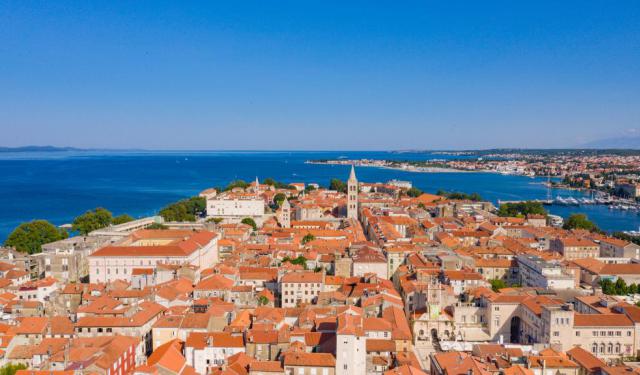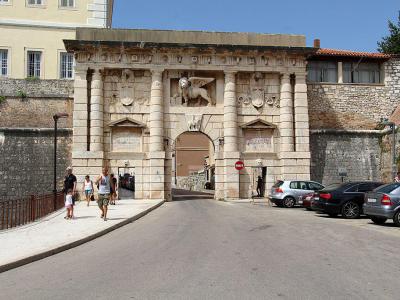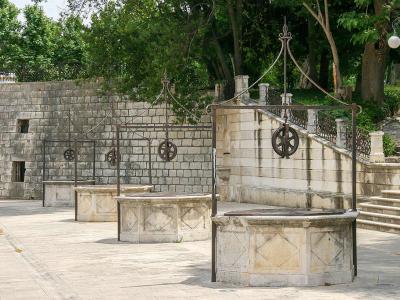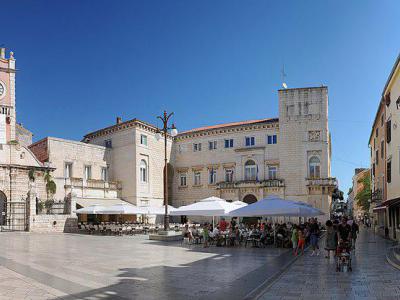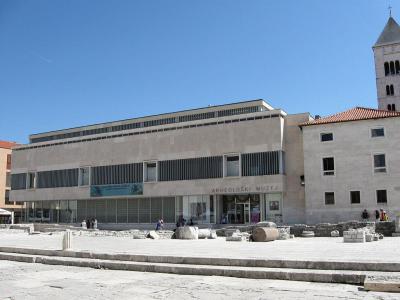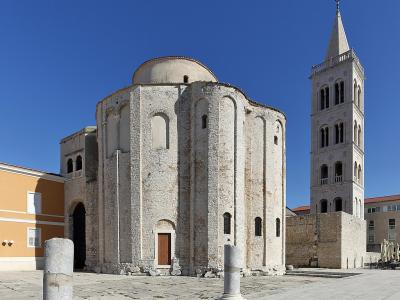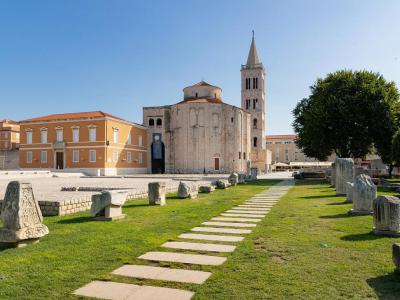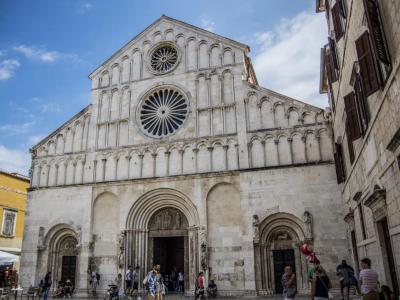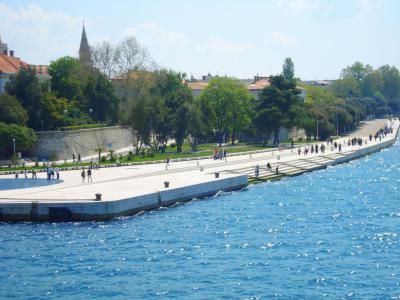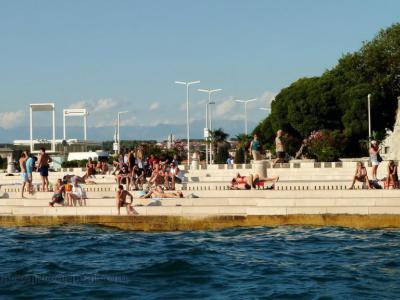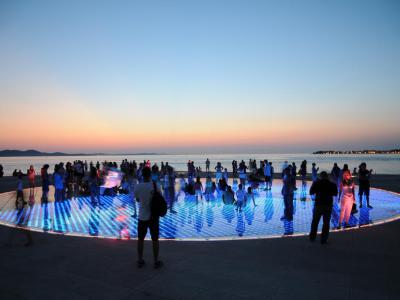Audio Guide: Zadar Introduction Walking Tour (Self Guided), Zadar
Famous Hollywood film director Alfred Hitchcock was captivated by Zadar’s stunning coastline. He even ranked its sunset above that of Key West, Florida.
Zadar rises from a rocky promontory that once stood apart from the mainland, and its earliest name, Jadera, is linked to the Illyrian tribes who settled along the Adriatic coast as early as the 9th century BC. Rome arrived in 59 BC, with Julius Caesar himself elevating Jadera to municipality status. The Romans left a lasting legacy: a grid of streets, aqueducts, and the Forum, built under Emperor Augustus. Even in fragments, this open-air square remains a defining part of the city-a place where commerce, politics, and ritual once converged.
As the Western Roman Empire fractured, Zadar entered the Byzantine sphere, becoming the capital of the Byzantine province of Dalmatia from the 7th century onward. During this period, Christianity firmly took root, and in the 9th century the Church of St. Donatus was constructed. Built partly from stones repurposed from the Roman Forum, this distinctive circular church remains one of the best-preserved pre-Romanesque monuments in Croatia.
From the 11th to the 14th centuries, Zadar found itself caught between the rising power of Venice and the ambitions of Hungarian kings. After multiple sieges-including the notorious Fourth Crusade in 1202-the city was ultimately absorbed into the Venetian Republic in 1409. For the next four centuries, Zadar served as Venice’s main stronghold on the eastern Adriatic. The Venetians expanded fortifications, built grand gates, and transformed the city into a maritime fortress capable of withstanding Ottoman threats from the hinterland.
In 1797, Zadar passed to the Habsburgs, then briefly to the French, and eventually back to Austria, becoming the administrative capital of the Dalmatian region. In 1947, it was incorporated into Yugoslavia, and following the federation’s breakup in the 1990s, it became part of independent Croatia.
Today, downtown Zadar is a living museum. Roman ruins and the Church of St. Donatus are framed by Venetian gates and medieval walls. Along the waterfront, the Sea Organ and Greeting to the Sun installations shimmer in the sunlight, while squares like Five Wells and People’s Square invite moments of reflection in a city that is both ancient and vibrant.
So why not end your walk at the water’s edge? Find a seat on the steps of the Sea Organ and stay for what Alfred Hitchcock once called “the most beautiful sunset in the world.” As the sky ignites, the Sea Organ hums its melody, the light show begins, and people dance across the solar-powered tiles of the Greeting to the Sun. It's a moment that stays with you-don’t miss it.
Zadar rises from a rocky promontory that once stood apart from the mainland, and its earliest name, Jadera, is linked to the Illyrian tribes who settled along the Adriatic coast as early as the 9th century BC. Rome arrived in 59 BC, with Julius Caesar himself elevating Jadera to municipality status. The Romans left a lasting legacy: a grid of streets, aqueducts, and the Forum, built under Emperor Augustus. Even in fragments, this open-air square remains a defining part of the city-a place where commerce, politics, and ritual once converged.
As the Western Roman Empire fractured, Zadar entered the Byzantine sphere, becoming the capital of the Byzantine province of Dalmatia from the 7th century onward. During this period, Christianity firmly took root, and in the 9th century the Church of St. Donatus was constructed. Built partly from stones repurposed from the Roman Forum, this distinctive circular church remains one of the best-preserved pre-Romanesque monuments in Croatia.
From the 11th to the 14th centuries, Zadar found itself caught between the rising power of Venice and the ambitions of Hungarian kings. After multiple sieges-including the notorious Fourth Crusade in 1202-the city was ultimately absorbed into the Venetian Republic in 1409. For the next four centuries, Zadar served as Venice’s main stronghold on the eastern Adriatic. The Venetians expanded fortifications, built grand gates, and transformed the city into a maritime fortress capable of withstanding Ottoman threats from the hinterland.
In 1797, Zadar passed to the Habsburgs, then briefly to the French, and eventually back to Austria, becoming the administrative capital of the Dalmatian region. In 1947, it was incorporated into Yugoslavia, and following the federation’s breakup in the 1990s, it became part of independent Croatia.
Today, downtown Zadar is a living museum. Roman ruins and the Church of St. Donatus are framed by Venetian gates and medieval walls. Along the waterfront, the Sea Organ and Greeting to the Sun installations shimmer in the sunlight, while squares like Five Wells and People’s Square invite moments of reflection in a city that is both ancient and vibrant.
So why not end your walk at the water’s edge? Find a seat on the steps of the Sea Organ and stay for what Alfred Hitchcock once called “the most beautiful sunset in the world.” As the sky ignites, the Sea Organ hums its melody, the light show begins, and people dance across the solar-powered tiles of the Greeting to the Sun. It's a moment that stays with you-don’t miss it.
How it works: Download the app "GPSmyCity: Walks in 1K+ Cities" from Apple App Store or Google Play Store to your mobile phone or tablet. The app turns your mobile device into a personal tour guide and its built-in GPS navigation functions guide you from one tour stop to next. The app works offline, so no data plan is needed when traveling abroad.
Zadar Introduction Walking Tour Map
Guide Name: Zadar Introduction Walking Tour
Guide Location: Croatia » Zadar (See other walking tours in Zadar)
Guide Type: Self-guided Walking Tour (Sightseeing)
# of Attractions: 10
Tour Duration: 1 Hour(s)
Travel Distance: 1.6 Km or 1 Miles
Author: DanaOffice
Sight(s) Featured in This Guide:
Guide Location: Croatia » Zadar (See other walking tours in Zadar)
Guide Type: Self-guided Walking Tour (Sightseeing)
# of Attractions: 10
Tour Duration: 1 Hour(s)
Travel Distance: 1.6 Km or 1 Miles
Author: DanaOffice
Sight(s) Featured in This Guide:
- Land Gate
- Five Wells Square
- People's Square
- Archaeological Museum of Zadar
- Church of St. Donatus
- The Roman Forum
- Zadar Cathedral
- The Promenade
- Sea Organ
- Greeting to the Sun
1) Land Gate (must see)
The Land Gate carries with it the drama of a city long caught between empires. Built in 1543 by Michele Sanmicheli, Venice’s celebrated military architect, it was conceived not only as a point of defense but as a grand statement of authority. At the time, Zadar stood as the Venetian Republic’s most important bastion on the eastern Adriatic, a city constantly under the shadow of Ottoman expansion. Fortifications were more than stone-they were the language of survival, and the Land Gate was crafted to speak that language boldly.
Rising above the narrow Fosa harbor, the gate acted as the city’s ceremonial entrance from the mainland. Unlike the stark fortresses that lined Venetian holdings elsewhere, this structure was built to impress travelers, merchants, and dignitaries as much as to keep invaders out. Passing through it meant stepping from the Dalmatian hinterland into a stronghold of the Serenissima, where symbols of power were etched into stone. Most striking of these was the winged lion of St. Mark, the unmistakable emblem of Venice, staring down from above the archway to remind all who entered whose flag flew over Zadar. Beneath it, reliefs of local saints added a distinctly Dalmatian voice to the otherwise Venetian narrative.
For centuries, this was the threshold across which countless lives flowed-sailors arriving from distant ports, soldiers marching under banners, peasants bringing goods to market, and nobles on their way to councils. The gate absorbed all of it, each passage a layer of Zadar’s story.
Though it no longer guards against armies, the Land Gate still performs its old function: it announces arrival. Step through its arches, and you enter a city where Roman forums, medieval churches, and Venetian palaces stand side by side-a living reminder of the crossroads that Zadar has always been.
Rising above the narrow Fosa harbor, the gate acted as the city’s ceremonial entrance from the mainland. Unlike the stark fortresses that lined Venetian holdings elsewhere, this structure was built to impress travelers, merchants, and dignitaries as much as to keep invaders out. Passing through it meant stepping from the Dalmatian hinterland into a stronghold of the Serenissima, where symbols of power were etched into stone. Most striking of these was the winged lion of St. Mark, the unmistakable emblem of Venice, staring down from above the archway to remind all who entered whose flag flew over Zadar. Beneath it, reliefs of local saints added a distinctly Dalmatian voice to the otherwise Venetian narrative.
For centuries, this was the threshold across which countless lives flowed-sailors arriving from distant ports, soldiers marching under banners, peasants bringing goods to market, and nobles on their way to councils. The gate absorbed all of it, each passage a layer of Zadar’s story.
Though it no longer guards against armies, the Land Gate still performs its old function: it announces arrival. Step through its arches, and you enter a city where Roman forums, medieval churches, and Venetian palaces stand side by side-a living reminder of the crossroads that Zadar has always been.
2) Five Wells Square
Five Wells Square is a reminder of how survival can shape a city’s identity. In the 16th century, when the Ottomans threatened Venetian Dalmatia, Zadar’s rulers knew that walls alone would not save them-water was just as vital. In 1574 they built a huge underground cistern and crowned it with five stone wells in a neat line, ensuring that the population could endure a siege without thirst. For years, those wells were not only the city’s lifeline but also symbols of Venetian resolve in a time of constant danger.
As peace gradually replaced urgency, the wells slipped into the rhythms of daily life. Generations of Zadrans drew water here, their comings and goings etching invisible patterns into the square. Wars came and went, rulers changed, but the wells stood steady, their stone lids and carved details quietly marking the passage of time. What had once been a fortress-like necessity slowly became a civic space where neighbors gathered and children played, the echo of survival now softened into routine.
By the 19th century, the square gained new companions: the Captain’s Tower, a relic of earlier defenses, and Queen Jelena Madije Park, Croatia’s first public park. With greenery and open space, Five Wells Square shifted again, this time into a social heart for the community.
Today, visitors stand among those same five wells and sense the layers of history. The square carries memories of sieges and resilience but also hums with concerts, events, and the everyday flow of people moving between Old Town and park. What began as a shield has become one of Zadar’s most beloved gathering places, where the past lingers quietly in the present.
As peace gradually replaced urgency, the wells slipped into the rhythms of daily life. Generations of Zadrans drew water here, their comings and goings etching invisible patterns into the square. Wars came and went, rulers changed, but the wells stood steady, their stone lids and carved details quietly marking the passage of time. What had once been a fortress-like necessity slowly became a civic space where neighbors gathered and children played, the echo of survival now softened into routine.
By the 19th century, the square gained new companions: the Captain’s Tower, a relic of earlier defenses, and Queen Jelena Madije Park, Croatia’s first public park. With greenery and open space, Five Wells Square shifted again, this time into a social heart for the community.
Today, visitors stand among those same five wells and sense the layers of history. The square carries memories of sieges and resilience but also hums with concerts, events, and the everyday flow of people moving between Old Town and park. What began as a shield has become one of Zadar’s most beloved gathering places, where the past lingers quietly in the present.
3) People's Square
People’s Square has been the civic heart of Zadar since the Middle Ages, when the Roman Forum began to fade from daily use. By the 16th century, the Venetians, keen to stamp their authority on the city, framed the square with buildings that blended administration with spectacle. The City Guardhouse, erected in 1562, served as both watchtower and symbol of control, while opposite it the City Cloister acted as the town’s public stage. Here laws were read, verdicts declared, and proclamations posted for all to see-turning the square into the place where Zadar’s identity was broadcast.
Life in the square was not only about officials and decrees. Over the centuries, markets spread across its stones, people gathered to celebrate festivals or mourn misfortunes, and cafés slowly appeared, filling the air with the scent of coffee and chatter. The buildings may have been Venetian in origin, but the rhythms of the square belonged to the townspeople, who kept returning to this spot under changing rulers-be they Austrians, Italians, or Yugoslav administrators. Even the nearby Church of Saint Lawrence, tucked behind a modern café, and the occasional exhibitions in the old Guardhouse show how the past and present intermingle here.
People’s Square is alive with cafés, shops, and conversations spilling out onto the pavement. For visitors, it is not just another stop in the Old Town but a window into centuries of continuity, where Zadar’s history and community life still beat in the same open space.
Life in the square was not only about officials and decrees. Over the centuries, markets spread across its stones, people gathered to celebrate festivals or mourn misfortunes, and cafés slowly appeared, filling the air with the scent of coffee and chatter. The buildings may have been Venetian in origin, but the rhythms of the square belonged to the townspeople, who kept returning to this spot under changing rulers-be they Austrians, Italians, or Yugoslav administrators. Even the nearby Church of Saint Lawrence, tucked behind a modern café, and the occasional exhibitions in the old Guardhouse show how the past and present intermingle here.
People’s Square is alive with cafés, shops, and conversations spilling out onto the pavement. For visitors, it is not just another stop in the Old Town but a window into centuries of continuity, where Zadar’s history and community life still beat in the same open space.
4) Archaeological Museum of Zadar
The Archaeological Museum of Zadar is not simply a building filled with artifacts; it is a storyteller of more than 3,000 years of life on the Adriatic coast. Founded in 1832, during a period when Europe was beginning to catalogue and study its past with new enthusiasm, it quickly became one of the oldest institutions of its kind in Croatia. Its first home was inside the round Church of St. Donatus, before moving across to its present location on the edge of Zadar’s Roman Forum-a symbolic placement that ties its collections directly to the city’s ancient core.
Inside, the museum guides visitors through the sweep of history, from the earliest prehistoric communities who left behind pottery, tools, and jewelry, to the powerful centuries when Rome made Zadar-then called Jadera-a key settlement. The Roman period emerges as one of the richest chapters: inscriptions, mosaics, and fragments from the Forum reflect both the civic pride and cultural ambition of the empire. Statues of emperors such as Caesar and Tiberius, alongside everyday objects, bring to life a city that balanced grandeur with daily routines.
The narrative continues through early Christianity and the Middle Ages, when Zadar became a frontier of faith and politics under Byzantine and Croatian influence. Intricately carved stone furniture, liturgical items, and grave goods speak to the endurance of belief and identity in turbulent times.
Walking through its galleries, the museum becomes less about display cases and more about connection. Each object, from a prehistoric tool to a medieval cross, is a thread in Zadar’s long story. For travelers, the museum is not just an archive but a reminder that beneath the city’s modern hum lies a history as deep and enduring as the stones of the Forum outside.
Inside, the museum guides visitors through the sweep of history, from the earliest prehistoric communities who left behind pottery, tools, and jewelry, to the powerful centuries when Rome made Zadar-then called Jadera-a key settlement. The Roman period emerges as one of the richest chapters: inscriptions, mosaics, and fragments from the Forum reflect both the civic pride and cultural ambition of the empire. Statues of emperors such as Caesar and Tiberius, alongside everyday objects, bring to life a city that balanced grandeur with daily routines.
The narrative continues through early Christianity and the Middle Ages, when Zadar became a frontier of faith and politics under Byzantine and Croatian influence. Intricately carved stone furniture, liturgical items, and grave goods speak to the endurance of belief and identity in turbulent times.
Walking through its galleries, the museum becomes less about display cases and more about connection. Each object, from a prehistoric tool to a medieval cross, is a thread in Zadar’s long story. For travelers, the museum is not just an archive but a reminder that beneath the city’s modern hum lies a history as deep and enduring as the stones of the Forum outside.
5) Church of St. Donatus (must see)
The Church of Saint Donatus is not only Zadar’s most famous landmark but also one of its most enduring stories. Its beginnings lie in the 8th and 9th centuries, when Donatus, bishop and diplomat, left his mark on the city. Known as a saint and envoy, he traveled to Constantinople and even to the court of Charlemagne, carrying back relics and influence that tied Dalmatia to the great powers of the time. It was under his direction that the church was built, originally dedicated to the Holy Trinity but later bearing his name, a reminder of the man who shaped both its stones and its legacy.
The site chosen was the very heart of Roman Zadar, the Forum. Blocks from temples and colonnades were repurposed into the church’s foundations and walls, fusing the pagan past with the rising Christian order. Its bold circular design, unlike the basilicas common of the period, gave it a distinctive identity-two concentric galleries wrapped around a central space, its plain stone echoing the austerity of the pre-Romanesque age. The effect was both simple and monumental, a building that looked back to Ravenna and Aachen while remaining firmly rooted in Dalmatian soil.
Survival was not always guaranteed. The church endured sieges, wars, and even the Mongol invasions of the 13th century. Later, the Venetians, French, and Austrians stripped it of its sacred role and turned it into a warehouse. Under Yugoslavia, it became an archaeological museum. Yet each reinvention preserved it, and today its thick walls host concerts and cultural festivals, its acoustics making it a favorite for music that feels timeless in such a space.
Stepping into St. Donatus is stepping into the continuity of Zadar itself-Roman stones, medieval faith, foreign rule, and modern revival all bound within its circular walls. It is less a monument than a living echo, where centuries of resilience and reinvention still resonate.
The site chosen was the very heart of Roman Zadar, the Forum. Blocks from temples and colonnades were repurposed into the church’s foundations and walls, fusing the pagan past with the rising Christian order. Its bold circular design, unlike the basilicas common of the period, gave it a distinctive identity-two concentric galleries wrapped around a central space, its plain stone echoing the austerity of the pre-Romanesque age. The effect was both simple and monumental, a building that looked back to Ravenna and Aachen while remaining firmly rooted in Dalmatian soil.
Survival was not always guaranteed. The church endured sieges, wars, and even the Mongol invasions of the 13th century. Later, the Venetians, French, and Austrians stripped it of its sacred role and turned it into a warehouse. Under Yugoslavia, it became an archaeological museum. Yet each reinvention preserved it, and today its thick walls host concerts and cultural festivals, its acoustics making it a favorite for music that feels timeless in such a space.
Stepping into St. Donatus is stepping into the continuity of Zadar itself-Roman stones, medieval faith, foreign rule, and modern revival all bound within its circular walls. It is less a monument than a living echo, where centuries of resilience and reinvention still resonate.
6) The Roman Forum
The Roman Forum is less a ruin in the traditional sense and more a stage where the city’s history continues to play out. Laid out in the 1st century BC under Emperor Augustus, it was once the beating heart of Jadera, as Zadar was then known. Here, politics were debated, trade was carried out, and rituals tied the community together under the gaze of temples and colonnades. Julius Caesar had already granted the city municipal status, and the Forum stood as proof of Rome’s ambition to anchor its power on the Dalmatian coast.
Time, however, brought change. As the Western Roman Empire collapsed, temples and arches fell into ruin, but the stones themselves remained useful. By the early Middle Ages, Christians reused columns and blocks to construct new churches, most famously the Church of St. Donatus, which rises directly from the Forum’s edge. This reuse of Roman materials gave the square a second life, binding together pagan Rome and Christian Europe in the same space. Later rulers, from Byzantines to Venetians, lived among the remnants and built their own marks around it, each acknowledging the Forum’s centrality in some form.
Visitors walking across its paving stones still sense that long continuity. Broken columns stand solitary yet dignified, while fragments of walls and temples hint at the grandeur that once framed the square. Surrounded by medieval churches and later buildings, the Forum has become a place where eras blend seamlessly. For travelers, it is not so much about ruins preserved as relics, but about the feeling of standing where two thousand years of civic life once converged. To pause here is to sense empire, faith, and community echoing across the same stones that once defined Zadar’s place in the Adriatic world.
Time, however, brought change. As the Western Roman Empire collapsed, temples and arches fell into ruin, but the stones themselves remained useful. By the early Middle Ages, Christians reused columns and blocks to construct new churches, most famously the Church of St. Donatus, which rises directly from the Forum’s edge. This reuse of Roman materials gave the square a second life, binding together pagan Rome and Christian Europe in the same space. Later rulers, from Byzantines to Venetians, lived among the remnants and built their own marks around it, each acknowledging the Forum’s centrality in some form.
Visitors walking across its paving stones still sense that long continuity. Broken columns stand solitary yet dignified, while fragments of walls and temples hint at the grandeur that once framed the square. Surrounded by medieval churches and later buildings, the Forum has become a place where eras blend seamlessly. For travelers, it is not so much about ruins preserved as relics, but about the feeling of standing where two thousand years of civic life once converged. To pause here is to sense empire, faith, and community echoing across the same stones that once defined Zadar’s place in the Adriatic world.
7) Zadar Cathedral (must see)
Zadar Cathedral, dedicated to Saint Anastasia, carries with it more than eight centuries of layered history and devotion. Long before the present Romanesque church rose in the 12th and 13th centuries, the site held an early Christian basilica, built in the 5th century and originally dedicated to Saint Peter. Its transformation into the cathedral we know today was guided by both local faith and the influence of powerful neighbors across the Adriatic, but its heart is bound to the story of Saint Anastasia. In the 9th century, Bishop Donatus received her relics from Emperor Nikephoros I, and they were placed in a marble sarcophagus that still rests inside the church, giving Zadar a spiritual connection that extended far beyond Dalmatia.
Over time, the cathedral became both symbol and stage for the city’s triumphs and trials. In 1202, the Fourth Crusade struck Zadar, leaving the church heavily damaged and in need of rebuilding. Under Venetian rule it regained its prominence, its bell tower rising above the old town as both a marker of faith and a reminder of foreign oversight. Even in the modern era the cathedral bore scars of war-bombing raids during World War II damaged parts of the structure, though once again it was restored, just as the city itself endured.
Walking through today, visitors encounter more than relics of faith. The sarcophagus of Saint Anastasia still anchors the apse, while mosaics, carved stone, and later altars speak to centuries of adaptation. The bell tower, completed in the 19th century, now offers sweeping views over rooftops, harbor, and sea, extending the cathedral’s role as a lookout from history into the present. To stand inside this building is to feel Zadar’s resilience, a city whose cathedral continues to gather its people through faith, memory, and the passage of time.
Over time, the cathedral became both symbol and stage for the city’s triumphs and trials. In 1202, the Fourth Crusade struck Zadar, leaving the church heavily damaged and in need of rebuilding. Under Venetian rule it regained its prominence, its bell tower rising above the old town as both a marker of faith and a reminder of foreign oversight. Even in the modern era the cathedral bore scars of war-bombing raids during World War II damaged parts of the structure, though once again it was restored, just as the city itself endured.
Walking through today, visitors encounter more than relics of faith. The sarcophagus of Saint Anastasia still anchors the apse, while mosaics, carved stone, and later altars speak to centuries of adaptation. The bell tower, completed in the 19th century, now offers sweeping views over rooftops, harbor, and sea, extending the cathedral’s role as a lookout from history into the present. To stand inside this building is to feel Zadar’s resilience, a city whose cathedral continues to gather its people through faith, memory, and the passage of time.
8) The Promenade (must see)
Zadar’s waterfront promenade owes its existence to both war and peace. For centuries, the city stood as one of the most heavily fortified outposts of the Venetian Empire, its elaborate system of walls keeping Ottoman armies at bay. By the 19th century, under Austrian rule, sieges were no longer a threat, and the great southern ramparts were torn down. In their place, between 1871 and 1874, a broad, tree-lined promenade was created, offering townspeople a space to breathe, gather, and look out across the Adriatic.
From its beginning, the promenade was more than just a walkway-it became the city’s stage. Families strolled there on Sunday afternoons, sailors embraced loved ones after long voyages, and children discovered the freedom of their first bike rides. Even during the dark days of the 20th century-wars, occupations, and repeated bombings during World War II-the promenade held its ground as a place of continuity, a strip of openness linking the city’s past to its uncertain future. Locals often describe Zadar itself as a “Stone Vessel,” its elongated peninsula resembling a ship at sea, and nowhere does that image feel more real than along the seawall of the Riva.
Today, the promenade balances old memories with modern imagination. Palms and cafés frame the walk, while two remarkable 21st-century installations bring new life to the shore. The Sea Organ, carved steps that transform the rhythm of waves into music, fills the air with haunting tones. Nearby, the Greeting to the Sun-a solar-powered circle that glows after dusk-turns the pavement into a light show. Together, they give the Riva its unique blend of history and innovation. At sunset, when the sky turns gold over the islands, the promenade becomes not just Zadar’s front porch but its soul.
From its beginning, the promenade was more than just a walkway-it became the city’s stage. Families strolled there on Sunday afternoons, sailors embraced loved ones after long voyages, and children discovered the freedom of their first bike rides. Even during the dark days of the 20th century-wars, occupations, and repeated bombings during World War II-the promenade held its ground as a place of continuity, a strip of openness linking the city’s past to its uncertain future. Locals often describe Zadar itself as a “Stone Vessel,” its elongated peninsula resembling a ship at sea, and nowhere does that image feel more real than along the seawall of the Riva.
Today, the promenade balances old memories with modern imagination. Palms and cafés frame the walk, while two remarkable 21st-century installations bring new life to the shore. The Sea Organ, carved steps that transform the rhythm of waves into music, fills the air with haunting tones. Nearby, the Greeting to the Sun-a solar-powered circle that glows after dusk-turns the pavement into a light show. Together, they give the Riva its unique blend of history and innovation. At sunset, when the sky turns gold over the islands, the promenade becomes not just Zadar’s front porch but its soul.
9) Sea Organ (must see)
There is a "wave" organ in San Francisco. There is also a "high tide" organ in Blackpool. The Sea Organ of Zadar is more musical. It plays tunes. Designed by Croatian architect Nikola Bašić in 2005, it was part of a wider effort to bring life back to Zadar’s battered waterfront. After the bombings of World War II and the rushed postwar reconstruction, the seawall was functional but soulless-a hard edge between land and sea. Bašić’s vision gave it not just beauty, but a voice. The project was so striking it earned him the European Prize for Urban Public Space in the same year.
At first glance, the Sea Organ appears as a set of broad white marble steps leading into the water at the edge of the promenade. Beneath them, however, lies a system of pipes tuned to different chords. As waves push air through the tubes, the steps give out a sound unlike anything else-low, resonant notes rising and falling with the rhythm of the sea. Sometimes the music is gentle, like a lullaby carried on the tide; other times it swells with unexpected force, echoing the mood of the Adriatic. No two moments are alike, and the result is an endless, improvised symphony shaped by wind and water.
For locals, the Organ has quickly become a part of daily life, a spot where walks along the promenade pause to listen. For visitors, it is both spectacle and meditation-feeling the vibration of sound underfoot as the sea plays its song. Alfred Hitchcock once called Zadar’s sunsets the most beautiful in the world; today they are accompanied by music, as the horizon burns with light and the Organ hums with harmony. From a scarred seawall grew a work that unites nature, art, and resilience in one unforgettable experience.
At first glance, the Sea Organ appears as a set of broad white marble steps leading into the water at the edge of the promenade. Beneath them, however, lies a system of pipes tuned to different chords. As waves push air through the tubes, the steps give out a sound unlike anything else-low, resonant notes rising and falling with the rhythm of the sea. Sometimes the music is gentle, like a lullaby carried on the tide; other times it swells with unexpected force, echoing the mood of the Adriatic. No two moments are alike, and the result is an endless, improvised symphony shaped by wind and water.
For locals, the Organ has quickly become a part of daily life, a spot where walks along the promenade pause to listen. For visitors, it is both spectacle and meditation-feeling the vibration of sound underfoot as the sea plays its song. Alfred Hitchcock once called Zadar’s sunsets the most beautiful in the world; today they are accompanied by music, as the horizon burns with light and the Organ hums with harmony. From a scarred seawall grew a work that unites nature, art, and resilience in one unforgettable experience.
10) Greeting to the Sun (must see)
"Good Morning Starshine" goes to the song from the sixties musical "HAIR." Well, the Sun is a star, so, "The Earth says hello." Zadar says hello to the Sun and shines back his light in the evening. Near to the incomparable Sea Organ of Nikola Basic on the Promenade of Zadar is another of his works, "The Greeting to the Sun." This bold installation, set into the stone promenade at the tip of the peninsula, is a vast circle of glass plates that capture solar energy by day and release it after dark in a dazzling show of shifting colors.
Bašić’s design was more than an artistic flourish; it was a symbolic act, a way of uniting nature and human creativity in one living gesture. As evening falls, the sun’s stored energy turns into an improvised light performance on the ground, drawing crowds who gather to watch the colors ripple and change. Children dash across the glowing surface, couples pause for photographs, and the circle itself seems to breathe with the rhythm of the sea nearby. Surrounding discs represent the solar system, while inscriptions along the edge note the city’s saints and their feast days, binding the cosmic to the local in a uniquely poetic way.
This monument works hand in hand with its neighbor, the Sea Organ. While one translates waves into sound, the other translates sunlight into light, together making the promenade not only a place to walk but a stage for nature’s own performance. It has quickly become one of Zadar’s most beloved sights, second only to the sunsets Alfred Hitchcock once praised as the world’s most beautiful. Watching the colors shift beneath your feet while the sky burns with twilight, you sense that Zadar has found a way to honor both its ancient past and its modern spirit-all through the simple act of greeting the sun.
Bašić’s design was more than an artistic flourish; it was a symbolic act, a way of uniting nature and human creativity in one living gesture. As evening falls, the sun’s stored energy turns into an improvised light performance on the ground, drawing crowds who gather to watch the colors ripple and change. Children dash across the glowing surface, couples pause for photographs, and the circle itself seems to breathe with the rhythm of the sea nearby. Surrounding discs represent the solar system, while inscriptions along the edge note the city’s saints and their feast days, binding the cosmic to the local in a uniquely poetic way.
This monument works hand in hand with its neighbor, the Sea Organ. While one translates waves into sound, the other translates sunlight into light, together making the promenade not only a place to walk but a stage for nature’s own performance. It has quickly become one of Zadar’s most beloved sights, second only to the sunsets Alfred Hitchcock once praised as the world’s most beautiful. Watching the colors shift beneath your feet while the sky burns with twilight, you sense that Zadar has found a way to honor both its ancient past and its modern spirit-all through the simple act of greeting the sun.
Walking Tours in Zadar, Croatia
Create Your Own Walk in Zadar
Creating your own self-guided walk in Zadar is easy and fun. Choose the city attractions that you want to see and a walk route map will be created just for you. You can even set your hotel as the start point of the walk.
Zadar's Architecture Walking Tour
Zadar's architecture is a tapestry woven with the threads of Roman, Byzantine, and medieval influences, each contributing to a rich and vibrant heritage. Indeed, as you walk the streets of Zadar, you can't help noticing a plethora of ancient buildings reflecting the varied cultural influences imposed on the city over the centuries.
This part of Croatia’s Dalmatian coast has been... view more
Tour Duration: 1 Hour(s)
Travel Distance: 1.2 Km or 0.7 Miles
This part of Croatia’s Dalmatian coast has been... view more
Tour Duration: 1 Hour(s)
Travel Distance: 1.2 Km or 0.7 Miles
The Most Popular Cities
/ view all
